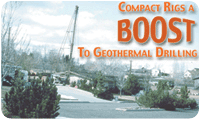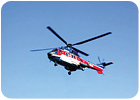
The ideal compact rig would save money and reduce environmental impact Drilling of moderately deep (10,000 ft.) oil, gas and geothermal wells historically has been done with very large drill rigs. Typically these large rigs have masts 120 feet to 140 feet tall, bulky, built-in-place substructures and multiple large engines to raise and lower drill strings, rotate the bit, circulate drilling fluids and generate electricity. Transport of these machines can require in excess of 100 truckloads and “rig-up” involves the use of cranes, bulldozers, forklifts, front-end loaders and/or other heavy construction equipment.
Today, the geothermal industry must compete with natural gas when trying to sell electricity to utilities. The highest single cost of geothermally generating power is the drilling of production and injection wells. Important components of the overall drilling costs include the cost of mobilization and demobilization, crew-related charges and fuel. When working overseas, the impact of these particular line items on total costs is even greater. Additionally, environmental concerns associated with the use of large drill rigs are increasing all over the world. These must be addressed if continued geothermal drilling is to be possible at reasonable costs.
If a smaller, more easily transportable and less expensive (to run) drill rig can be found or designed and built to drill deep geothermal production and injection wells, overall drilling costs (and electric power costs) can be decreased significantly. The use of compact rigs would help make geothermal resources more competitive as a power-generating fuel while at the same time decreasing the environmental impacts of operations conducted using large drill rigs.
For the sake of this discussion, a compact drill is defined as one that:
- Has a mast that is self-erecting and is significantly shorter than a conventional triples rig.
- Has a footprint that is far smaller than that of conventional rigs.
- Has a substructure that is high enough (20-30 ft.) to accommodate the blow-out prevention stacks commonly used in deep, high-temperature geothermal drilling, but which can be erected without the need for heavy equipment.
- Can be transported into steep terrain without the need to widen or reshape roads and without the need to push or pull with heavy equipment.
- Utilizes state-of-the-art technology to minimize bulk and complexity, while still maintaining the capacity to drill production-scale wells safely.
- Requires a small (3-4 man) crew on each tour.
- Can be transported over land or sea using about 20-25 truckloads.

Rig Style
There are three basic style alternatives: roadable (truck- or trailer-mounted), helicopter transportable and built-in-place. If the rig is to be roadable, the truck or tractor should have multi-wheel drive and a winch powerful enough to pull itself out of trouble when necessary. The truck or trailer should have a steerable rear axle. The overall wheelbase should be as short as possible so as to allow negotiation of sharp turns, and the truck also should be narrow enough (10-12 ft.) to fit on most bridges. The tractor should be diesel-powered (rather than gas-powered) and equipped with mufflers and a scrubber to minimize noise and exhaust emissions.If the rig is trailer-mounted, it can be smaller and less expensive since there is no prime mover (engine) on it and the only requirement is that it be built sturdily enough to withstand the rigors of being repeatedly moved. Though trailer-mounted rigs commonly are designed to be self-erecting, inclusion of a gin pole or other similar device on the tractor and/or availability of small, versatile, roadable lifting machines would be advisable.
In the case of a helicopter-transportable rig, it would have to be designed to fit, with 6 inches of clearance, in ocean-going containers commonly measuring 8-feet-by-8-feet-by-20-feet. Three general types of helicopters are available to transport these loads. The smallest, least expensive helicopters can only lift 4,000 pounds to 5,500 pounds. Though most rig components can be designed in pieces to meet this requirement, generators pose significant problems. Medium-sized helicopters can handle up to 8,000-pound lifts. They cost more, but they can transport most carefully sized rigs and ancillary components. Finally, there are the giant military helicopters that can lift up to 20,000 pounds. Although their base and operating costs are very high, their cost-per-transported-pound often is lower than the smaller helicopters and they can be cost-effective if it is not excessively expensive to mobilize these machines to the work location.
Built-in-place (conventional) rigs normally are large, heavy and typical of the kinds of machines that should be replaced by “compact” drill rigs. Accordingly, they will not be considered further.
Depth Capability
The ideal compact geothermal drill should have the power and the lifting/jacking capacity to be able to penetrate any rock type to a nominal depth of 10,000 feet and set casing to whatever depth is indicated. The depth capability is a function of the power and configuration of the draw works, the strength of the mast, the hook load “over pull” capacity and the torque available to rotate the drill string.
The draw works pull can be optimized by using a 10-line or 12-line pulley system if decreased hoisting rates can be tolerated. Adequate mast strength can be obtained using a relatively light design if the use of jacking systems is planned. (Jacks can push from the substructure to exert upward force on drill rods or on the casing string without the need for pulling from above with consequent imposition of great compressive stresses on a mast). The hook-load overpull capacity can also be decreased by planning on the use of jacks. Finally, generation of adequate torque from light, versatile top head drives is absolutely no problem.

Coring Capability
One of the most expensive aspects of geothermal drilling is the need to drill through lost circulation zones. When such conditions are encountered above the geothermal reservoir, much time and money can be spent regaining circulation with multiple cement jobs to seal the zone without sticking or twisting off the drill string. Core drilling is a proven solution to this problem because it can be done dry, i.e. without drilling mud returns to the surface. Accordingly, the compact drill rig should be designed to have both rotary and core drilling capabilities.The Mast
The mast should be no taller than necessary to pull doubles (two 30-foot long joints of drill rod or casing) while accommodating a top head drive, plus required blocks, swivels and other rigging. It is believed that such a mast could be less than 100 feet high. If jacks are used to remove stuck drill pipe, the mast will only need to be strong enough to support the pulling of about 300,000 pounds. It probably will be built as a steel skeleton; however, the use of new composite materials should be considered if they are cost-effective. The skeleton style would be light and versatile with respect to modification and repairs requiring welding.
It is possible that a mast could be designed to be collapsed to “singles” height when especially heavy pulls are required. If this were the case, then the fully extended, “doubles” height mast might be built lighter than otherwise. Consideration also should be given to building the mast only high enough to accommodate the pulling of singles. In this case, automated pipe handling should be planned if its use would make up for the time lost in not pulling doubles.
If the compact rig is designed to pull doubles, the rig floor and the finger board will have to be designed to hold the 167 60-foot stands needed to drill to 10,000 feet. Interestingly, no derrick man is employed on these rigs and the stands are stacked very efficiently by the driller using an automated system operated from the control console.
ND

Report Abusive Comment